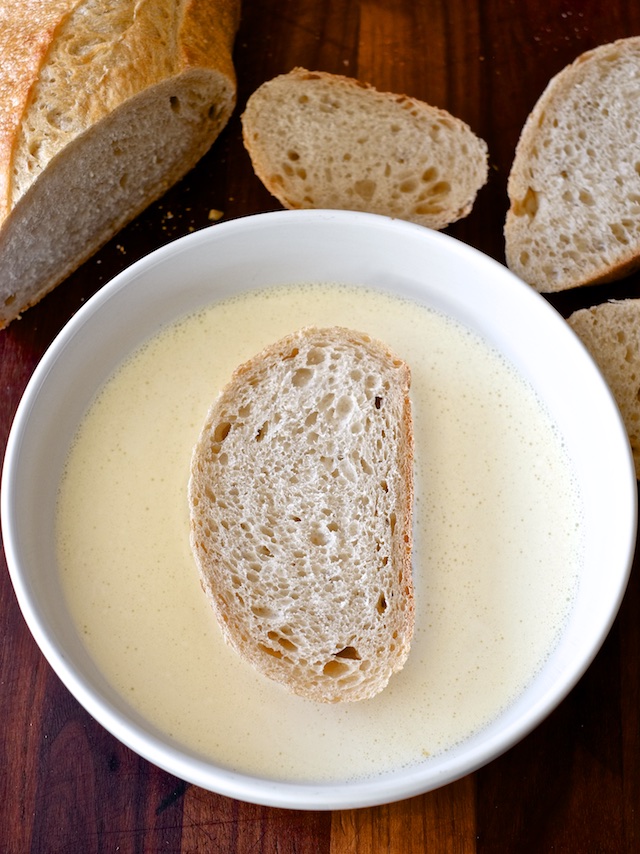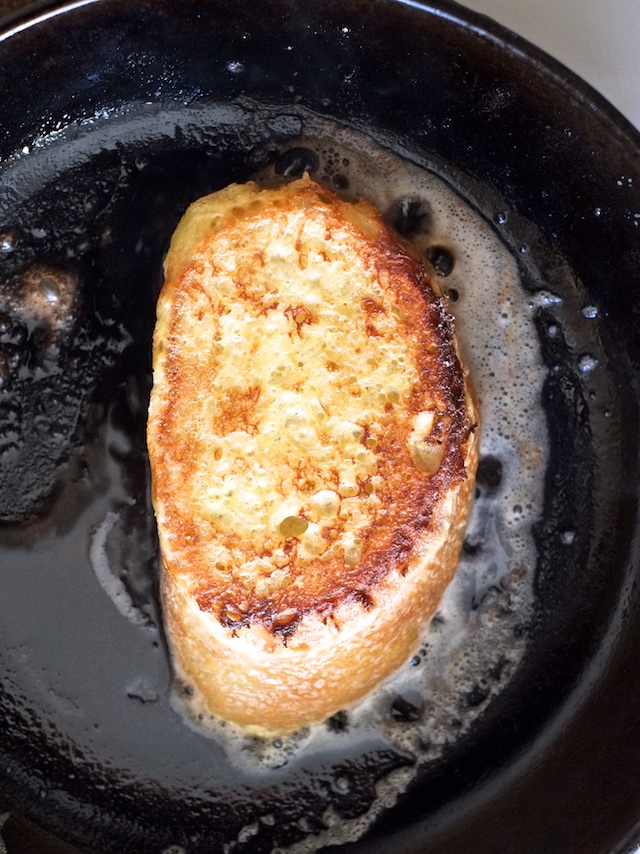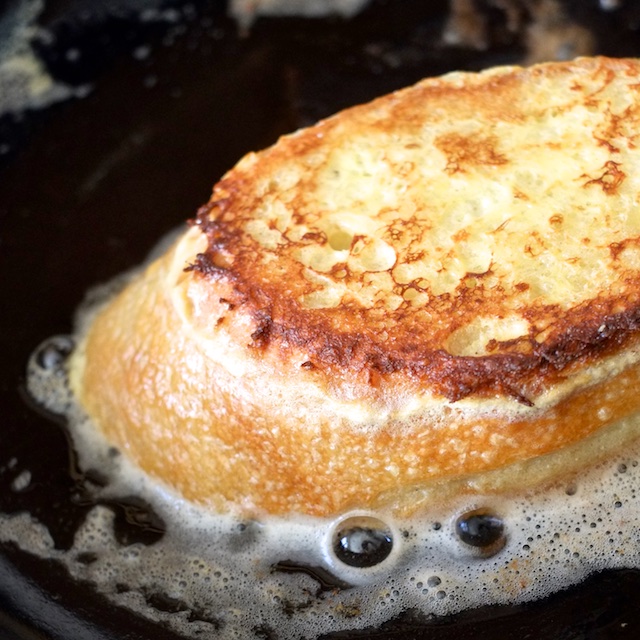
Understanding french toast begins with deconstruction and ends with deeeliciousness? (So lame, I’m sorry.) I really believe that the better you understand a food the easier it is to riff and cook it on the fly. So let’s break it down, put it back together, and drown it in syrup.
The Milk: I like half and half – it’s fatty enough to give the french toast a delicate richness and thin enough to give the custard good soaking abilities. Whole milk is ok, 2% can work if you’re desperate, but if you’re serious about french toast, use half and half.
The Ratio: I’m talking about how much half and half you use per egg. And I like to use a ratio here because it gives you the flexibility to make a few slices or a huge batch without too much fancy math. You want custard that’s rich yet delicate – a balance achieved with the ratio of one egg per half a cup of half and half.
The Bread: Lots of recipes recommend challah or brioche, and those are good, but I also adore sourdough and chewy breads with crisp crusts. Definitely slice the bread at least 3/4 inch thick, and up to an inch. Technically, you can french toast any bread you want with a little finesse…
The Soak: The bread you use will dictate the length of time it needs to soak. Light and delicate breads like white bread or croissants (yesss, you can french toast croissants) call for a shorter soak: like 15-20 seconds per side. Dense and chewy breads will need more time: as much as a minute per side. Properly soaked toast will have taken on some liquid weight, but won’t be falling apart when you try to move them out of the custard.
The Rest: I get that sometimes you’re in too big of a hurry to really let the french toast rest between the soak and the pan, but a short time between steps will really improve the texture of the final product, by allowing the bread to distribute the custard evenly through the center of the bread and shed any excess. If you use a bread with a large hole-structure do NOT skip this step, unless you like the idea of thick scrambled egg pockets in your lovely delicate french toast.

The Flavoring: If you’re making sweet french toast, (which you usually will be) I recommend adding a little sugar or honey to the custard for both flavor and extra-brown crispy caramelization in the pan. Cinnamon is classic, but you can get really creative here if you want – vanilla bean, nutmeg, black pepper – or take it savory with minced garlic or hot sauce (omitting the sweetener, obviously).
The Fat: Butter, always. The end.
The Cook: Go with a cast iron or nonstick pan on medium-low heat for about 2-3 minutes per side to set the custard and brown the outside (more if your toast is very thick). If you’re serving a group, bump up the heat to medium-high and focus on browning the toast. Worry less about setting the custard because you’ll be employing the oven to cook the toast through. After your batch is browned, place the french toast on a baking sheet and put it in a low, 300F oven for 10 minutes.
Now let’s put it together.

The Last French Toast Recipe You’ll Ever Need
Ingredients:
-your favorite french-toasting bread, sliced 3/4 to 1 inch thick.
-eggs, about one for every 3-4 slices of toast
-half and half, one half cup per egg
-1/8 tsp salt per egg
-1 tsp sugar or honey per egg (if making sweet french toast)
-butter, for cooking (keep a stick at the ready to re-load between slices)
-optional spices and herbs (for cinnamon, use about 1/4 tsp per egg)
Method:
1. Slice bread to desired thickness and set aside.
2. Make custard by whipping together eggs, half and half, salt, and sugar or any flavoring you’re using. I like to use a blender for perfectly smooth custard, but a whisk will do. Pour the custard into a wide bowl or pie tin.
3. Soak bread between 15 seconds and 1 minute per side, depending on the type of bread. Delicate breads should be soaked 15-20 seconds. Denser breads can need up to a minute per side.
4. Set the bread on a paper towel-lined baking sheet or plate and let it rest for at least a minute.
5. If you’re making a few slices, heat your pan to medium-low, add a tablespoon or two of butter, and cook your french toast 2-3 minutes per side or until the outside is satisfactorily brown and the custard is set in the middle (you may need more time per side if your toast is very thick and dense) and serve. If you’re making a big batch, set the pan to medium-high, add butter, brown the french toast on both sides, and place on a baking sheet. When all the toast is browned, line it up on the baking sheet and put it in a 300F oven for 10 minutes and serve.
Awesome tips - especially the 'finish it in the oven' one. French toast for a crowd always seems intimidating, but using the oven to finish/hold the batches would make it so much easier.
April @ Girl Gone Gourmet — March 19, 2015Thanks April! Timing is one of those things most people don't think about and most recipes don't mention, but it's probably the trickiest thing about cooking in my opinion, especially when you're feeding a crowd!
courtney — March 24, 2015[…] To read more tips on perfect french toast, visit sweetsaltytart.com. […]
Perfect French Toast | It's Penelope's Place — May 4, 2015